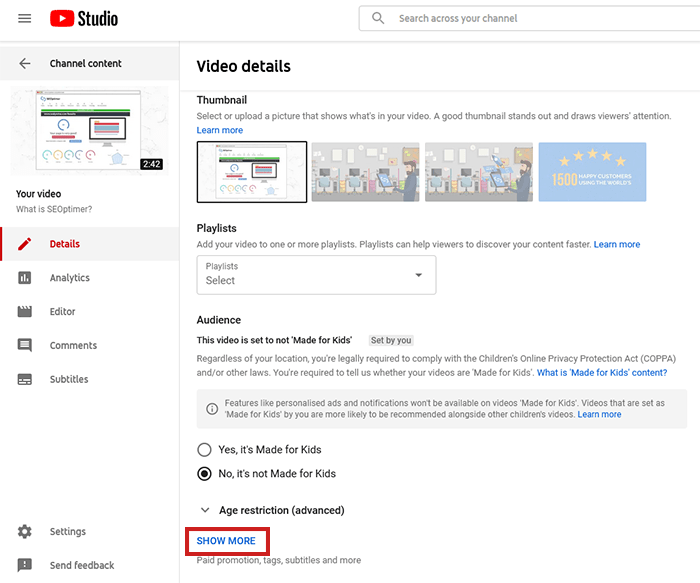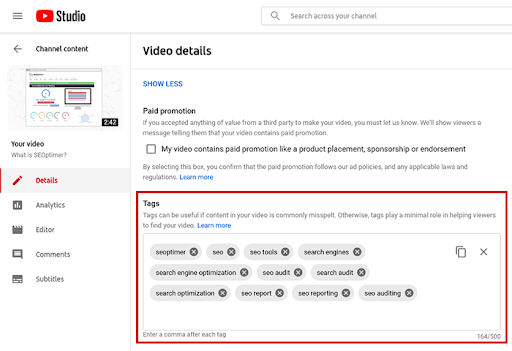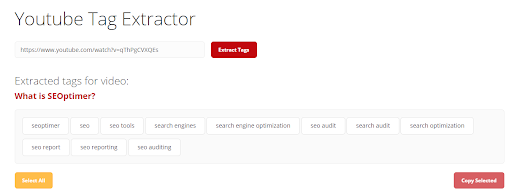YouTube tags are the hidden metatags associated with videos on YouTube. Not all videos have these tags as it’s up to the video publisher to add them when they upload the video.
The Tag Extractor tool is a handy way of extracting and revealing these meta tags associated with any public video. Extracting YouTube Tags can be very insightful to understand how competitor videos and other high-performing videos are using these tags to boost their performance.
Tags are not to be confused with HashTags which are displayed in the video description and above the video title.
What are YouTube Tags?
The confusing thing about YouTube is there are two types of tags:
- Tags: which are the invisible “meta” Tags associated with a video. This is what the Tag Extractor extracts
- HashTags: which are the visible tags shown above a video title. See more information about YouTube HashTags.
Tags are added to a video when it is uploaded on YouTube. Unlike HashTags, they do not have pound (#) signs in front of them and they can also contain spaces to encompass a string of multiple words. Best practice is to use all lowercase Tags with alpha-numeric characters.
Since these Tags are invisible on the actual video page, our friends at SEOptimer generously shared some screenshots with us so we can peek behind the scenes at how they tagged their videos.
In YouTube Studio, at the bottom of the “Video details” page is a hyperlink “Show More”:

Once this is clicked, it expands further options including “Tags”:

A YouTube video can have up to 500 characters worth of Tags - which is a lot! In the example above, we can see the SEOptimer video has 11 Tags. Altogether these Tags only take up 164 characters of the 500 limit, so there’s room for many more.
Now here comes the magic. Using the YouTube Tag Extractor, we can easily reveal these hidden meta tags with the click of a button:

You’ll notice, the Tags are importantly extracted in exactly the same order that the author has used. This gives you a really great insight about what the author thinks is (a) the most important topics in the video and; (b) the highest priority tags for video SEO.
Why are YouTube Tags important?
So now we know the YouTube Tag Extractor works like magic on any public YouTube video and extracts the invisible meta tags whilst maintaining the order of those Tags as denoted by the author of the video.
But why is this important? You’re likely reading this page at the moment because you’re interested in the overall topic of Video SEO. We know from YouTube themselves that many signals contribute to the overall ranking in the search result page (title, description, hashtags, thumbnail, tags, quality of video, etc).
We recommend getting the basics right and utilize all the features that YouTube provide to categorize and apply meaning to your videos. The jury might be out as to the degree of influence the hidden meta tags have on search result rankings, but our recommendation is always to err on the side of optimization and use all YouTube features together. After all, the more YouTube understands what your video is about, the more chance your videos will rank higher in YouTube search results.
YouTube Tags strategy
There are some strategic considerations when extracting Tags from competitor videos. There are two possible scenarios when extracting Tags from a YouTube video using this tool:
1. The video has no Tags: this is actually quite common since the Tags field is hidden behind the “Show More” text link right at the bottom of the video details page in YouTube Studio. So unless your competitors are YouTube-savvy, they will likely look straight past this and upload the video with zero tags. This is a good outcome for you because any tags you add to your video will be better. Consider the wording competitors use in the video title and description and if they use any HashTags in the video description.
2. The video has Tags: like the example above from SEOptimer which revealed 11 Tags on their video, the next step is to use your best judgement to assess the quality of these Tags. Try to look for anything unexpected or unusual about the Tags and the ordering of those Tags. Again, the above example from SEOptimer is a very typical group of Tags which start with the brand term “seoptimer”, then include broad category terms like “seo” and go wider to include sub-category or niche terms like “seo reporting”.
The ordering of these Tags gives you a big clue about how they think about their key terms. For direct competitors, we recommend using similar broad Tags to remain competitive but utilize some unique Tags as well to capture niche searches where you may have a competitive advantage.
The great thing about Tags is that you can edit them after you publish your videos too. So if you feel some of your videos could be performing better in search or competitors are outperforming you on some key terms, try editing your Tags accordingly.
One final consideration in thinking about your Tags is what YouTube describe directly above the Tags input box:
“Tags can be useful if content in your video is commonly misspelt”.
Since these Tags are hidden on the page, they are perfect for including common misspellings of your brand, product or service including other usage like colloquialisms, slang or other “internet language” used around your organization.
People online commonly abbreviate and use informal terms, so depending on your video, including some of these terms in the Tags field might be beneficial if it’s relevant.